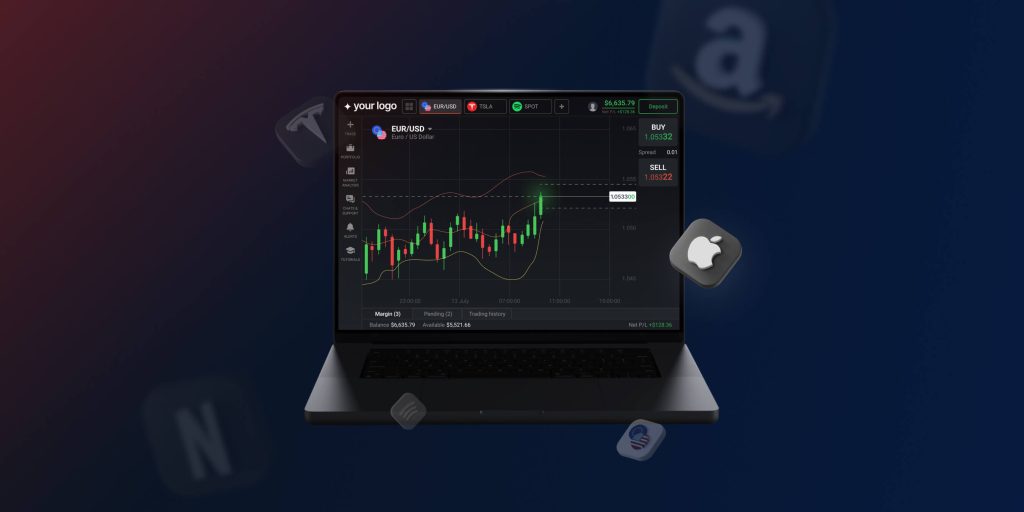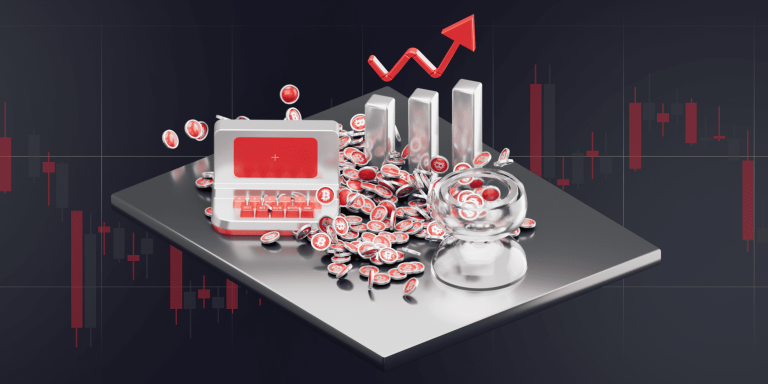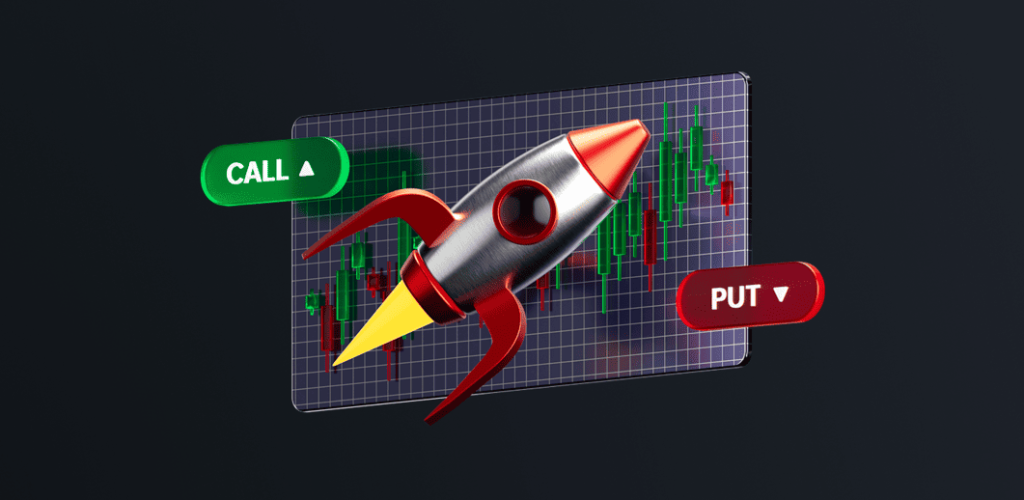
Top 10 Popular Trading Asset Classes For 2026
Contents
The best asset classes to trade in 2026 are driven by two key themes: the monetisation of Artificial Intelligence and a widespread investor mandate to diversify away from the most concentrated U.S. mega-cap equities. This is expressed in increased trading volume in AI-infused sectors, high-yielding credit, alternative assets, and well-performing international markets.
Some of these asset classes performed very well throughout 2024 to 2025, and are maintaining that stride into 2026. Understanding which asset classes have the most potential in such a hectic climate can significantly impact your trading success. Furthermore, spreading across multiple asset classes lowers risk while gaining maximum potential returns in an increasingly complex economic environment.
The top 10 popular trading asset classes for 2026 are:
- AI Value Chain and Technology Stocks
- Fixed Income (High-Yield Corporate Bonds)
- Cryptocurrencies (Institutional Adoption & AI-Integrated)
- International Equities (Japan & Europe)
- Exchange-Traded Funds (ETFs) (Thematic Granularity)
- U.S. Value and Small-Cap Stocks
- Energy and Energy Infrastructure Stocks
- Gold, Silver and Strategic Metals
- Short-Term Treasury Bills & Cash Alternatives
- Real Estate Investment Trusts (REITs) and Infrastructure Assets
Let’s delve deeper into each asset class and also consider some promising candidates in each class.
AI Value Chain and Technology Stocks
The 2026 thesis has shifted from AI hype to AI monetisation. Trading is now concentrated on firms with tangible products and services, building monumental, realised revenues from AI deployment. The global AI market size is projected to reach $2 trillion in 2026 from $757 billion in 2026. Certain segments are expanding at a Compound Annual Growth Rate (CAGR) of 19.20% over the next decade.
Top AI Stocks for 2026 include:
- Semiconductor & Memory Manufacturers driving AI infrastructure (The inescapable Hardware layer).
- Cloud Computing Companies powering AI workloads (The inescapable Infrastructure layer).
- Software companies demonstrating high-margin revenue from enterprise AI applications (The Application layer).
- Robotics and automation specialists.
Why AI Stocks Still Lead 2026 Trading:
- Huge Revenue Backlog: Firms are reporting enormous, verified revenue increases from AI-related services and products, far exceeding guidance.
- Increasing Corporate AI Adoption: The tipping point for business uptake of AI has been passed, driving sustained demand. Over 80% companies now deploy AI in core operations, according to McKinsey, fueling sustained demand across the stack.
- Government Funding and Support for domestic AI infrastructure.
There was little upside for many traders who pursued application-layer companies in 2024-2025. In comparison to more general tech indices, those who concentrated on foundational players, especially in semiconductors and cloud infrastructure, frequently experienced outperformance of 30%+. In 2026, this distinction will still be crucial.
Fixed Income
In 2026, the global bond market will enter a new phase that will be characterized by slower inflation, stabilized policy rates, and a renewed appetite for yields following three years of aggressive monetary tightening. Over the next 12 months, the Federal Reserve is generally predicted to lower interest rates, and the European Central Bank and Bank of England are following suit, albeit more slowly. One of the most alluring entry points for fixed-income investors in more than ten years is being created by this shift.
Why Attention Is Returning to Bonds
Bonds suffered for the majority of 2024-2025 due to high interest rates and unstable inflation. However, 2026 appears to be different. Bond prices are expected to increase, and yields are still historically high when compared to the ultra-low period of the 2010s, as global inflation is predicted to move closer to 2.4% to 3.0% and central banks are getting ready to ease.
Here are the top bond market segments for the 2026 Trader:
- High-Yield Corporate Bonds (The Income Focus): With yields in the 6.5%-7% range in developed markets, credit spreads are still appealing when compared to historical averages.
- Corporate Bonds for quality yield.
- Municipal Bonds for tax advantages.
- Treasury securities for safe-haven exposure and portfolio stability.
Benefits of Bond Trading:
- Expected Income Streams: Locking in attractive coupons before potential rate reductions.
- Reduced Price Volatility Risk: Rate stabilisation reduces the risk of steep price drops observed during the hiking cycle.
- Portfolio inflation protection and stability opportunities.
- Less volatility than stocks.
You may also like

Consider interest rate risk and credit risk when you purchase and sell bonds. Rising rates will hurt the prices of bonds, particularly on longer-term securities.
Cryptocurrencies
Cryptocurrencies remain at the forefront of trading innovation, but the catalyst for popularity in 2025 is inCryptocurrencies remain at the forefront of trading innovation, but the catalyst for popularity in 2026 is institutional legitimation, focus on AI-related tokens, and the explosive growth of tokenised real-world assets (RWAs).
This influx has not only solidified Bitcoin’s role as a de facto institutional asset but has also significantly improved market depth and liquidity.
Principal Cryptocurrency Trends for 2026
- Institutional Adoption: In the wake of spot Bitcoin and Ethereum ETF approval, institutional adoption is picking up pace, enhancing market liquidity and stability.
- AI-Integrated Cryptocurrencies: AI-related cryptocurrencies tied to decentralised AI, data verification, and machine learning are increasing rapidly.
- Tokenisation of assets is broadening market opportunities.
- Bitcoin and Ethereum remain at the forefront of the market as the underlying institutional assets.
The growth of on-chain yield strategies is another significant change in 2026. With yields that frequently match or surpass those of traditional markets, investors are increasingly looking to staking, lending, and tokenized fixed-income products for income. This, along with increased market infrastructure and deeper liquidity, makes the cryptocurrency ecosystem less speculative and more appealing than it was in earlier cycles.
Trading Advantages:
- 24/7 accessibility of markets.
- High volatility offers opportunities for gain.
- Increased Institutional Support has improved market infrastructure and liquidity.
- Lower barriers to entry compared to traditional markets.
Remember, cryptocurrency markets are extremely volatile. Therefore, effective risk management strategies have to be adopted when trading digital currencies.You can also check our guide on how to trade cryptocurrency for more information.
International Equities
While U.S. equity indexes remain highly concentrated and expensive, traders are actively pursuing diversification into global markets with better relative value and structural tailwinds.
A geopolitical and macroeconomic shift is also driving the trend: as trade disputes and tariffs reshape global supply chains, capital is moving toward regions like India, Southeast Asia, and portions of Latin America that are positioned as alternatives to U.S.-China dependencies. Reshoring, population growth, and robust domestic demand are all helping these regions.
2026 International Focus Areas:
- Japan: Driven by long-term corporate governance reforms and the resurgence of inflation.
- Europe: Offering strong cyclical rebound potential and more attractive valuations than the U.S.
- India and ASEAN: Currently leading global equity flows due to their fast GDP growth, expanding manufacturing, and expanding consumer markets.
- Latin America: The demand for vital minerals and energy transition materials is helping commodity-rich economies like Brazil and Chile.
Trading Advantages:
- Relative Value: More attractive valuations relative to the U.S. mega-caps.
- Exposure to non-U.S. economic cycles.
- Portfolio diversification advantages.
- Demographic and structural tailwinds in focused markets (e.g., Japan’s reform).
However, political instability, currency exposure, and regulatory changes can significantly impact global investments. Geographic and industry diversification is thus advised in consonance.
Exchange-Traded Funds (ETFs)
ETFs are gaining traction, with the global ETF industry expected to reach USD $20 trillion in AUM by the end of the year. The focus now is on thematic granularity, using ETFs to access targeted exposure to specific trends and hedging the risk of single-stock concentration.
The rise in actively managed ETFs and buffer ETFs, which combine expert management with intraday liquidity, is a noteworthy development this year. In an unpredictable macroeconomic climate, these products are drawing in both institutional and retail traders looking for improved downside protection and higher risk-adjusted returns.
Top ETF Themes for 2025:
- Thematic ETFs: Focusing on high-growth themes like Cybersecurity, Longevity/Healthcare Innovation, and Next-Gen Energy Infrastructure.
- Sector-Specific ETFs that target sectors of lower valuation and rebound potential tenders (e.g., Industrials, Financials).
- International ETFs for geographic diversification.
- International & Multi-Asset ETFs: Used to diversify away from U.S. concentration.
- Commodity and Bond ETFs for resource and fixed-income investing.
The quick incorporation of ESG and climate-focused strategies into ETF products is another noteworthy development in 2026. Although ESG faced challenges in the past, growing regulatory demands and global decarbonization objectives have rekindled interest in ETFs that focus on low-carbon, clean energy, and sustainable infrastructure portfolios, especially in Europe and Asia.
Advantages of ETFs:
- Instant diversification within a selected theme or sector.
- Lower costs than mutual funds.
- Intraday trading flexibility.
- Transparent holdings.
But compare underlying holdings and expense ratios before investing. Some niche ETFs could have greater costs or liquidity problems.
The expansion of 24/5-traded ETFs, or products that trade outside of regular market hours, is also increasing liquidity and allowing traders to respond to earnings announcements and macro events faster.You can check our top ETF trading strategies for more information on how to capitalise on price fluctuations.
U.S. Value and Small-Cap Stocks
While the U.S. market overall is grappling with focusing performance in a few mega-caps, 2026 is witnessing a renewed rotation into value and small-cap segments.
The U.S. reshoring wave, which is being fueled by supply-chain diversification, infrastructure spending, and industrial policy, is a significant driver this year. It is bringing new investment into industries like manufacturing, logistics, and energy infrastructure.
U.S. Value & Small-Cap Key Drivers:
- Growing Market: Capital migrating out of expensive mega-cap growth stocks into value areas that are off the radar screen.
- Favourable Rate Environment: Smaller companies, being more rate-sensitive, can benefit richly from the flattening of rates.
- Attractive Valuations: It trades at multi-year valuation discounts to the big indexes.
- M&A Momentum: Lower valuations and strategic repositioning are driving a resurgence in small-cap mergers and acquisitions.
These stocks will tend to be more volatile than those in the large-cap universe. Complete fundamental analysis is essential if you want to make the most of the available opportunity.
Energy and Energy Infrastructure Stocks
Commodity markets are driven by a two-way demand story in 2025: geopolitical risk tilting in favour of Commodity markets are driven by a two-way demand story in 2026: geopolitical risk tilting in favour of old energy, and the AI boom powering new demand for energy infrastructure. Brent crude futures averaged roughly USD $66/barrel in 2025, supporting energy sector revenues into 2026.
Key Commodity & Energy Sectors
- Energy Infrastructure & Utilities: Massive new demand for electricity (a 5-7x growth over 3-5 years) by data centres drives trading and investment in power grids and utilities.
- Energy Commodities (Oil & Natural Gas): Ongoing supply chain dislocations and geopolitical tensions continue to drive volatility and offer a price floor.
- Next-Generation Power Sources: In addition to oil and gas, policy incentives and growing corporate demand for clean baseload power are driving the growth of nuclear energy, battery storage, and hydrogen.
- Infrastructure support from industrial metals.
The incorporation of AI into energy grid management itself is another noteworthy development. Machine learning is being used by utilities and infrastructure providers to predict demand spikes and optimize energy distribution, increasing efficiency and cutting costs. As they become essential to the contemporary energy ecosystem, companies at the forefront of “smart grid” technology are attracting a lot of investor interest.
Commodity Trading Benefits:
- Inflation protection features.
- Structural Demand Drivers (AI & infrastructure).
- Global demand drivers.
However, commodity prices are very unstable and exposed to weather, political, and supply shock influences.
Gold, Silver and Strategic Metals
Gold, silver, and a growing group of strategic metals remain attractive to investors seeking portfolio insurance against inflation, economic uncertainty, and geopolitical risk.
In 2025, central banks bought a record 1,250 metric tons of gold, and as nations like China, India, and Turkey work to diversify their reserves away from the US dollar, that trend is continuing this year. In 2026, analysts predict that central banks will purchase almost 30% of all gold, which is a strong price support factor which backs bullish sentiment throughout the metals complex.
Drivers of Precious Metals Performance:
- Geopolitical Hedge: A haven commodity amid current global political and trading turbulence.
- Ability to hedge inflation in times of economic uncertainty.
- The central bank supported demand.
- Industrial Applications for Silver (renewable energy).
- De-Dollarisation Trend: Efforts by BRICS+ nations to reduce reliance on the U.S. dollar
Investor interest in strategic and critical metals other than the conventional gold-silver pair is another trend that is gaining traction in 2026. Essential to AI infrastructure, electric vehicle manufacturing, and renewable energy systems, metals like lithium, copper, and rare earth elements are increasingly being traded as part of a larger “strategic metals” basket. These assets provide additional benefits for portfolio diversification by combining inflation-hedging capabilities with industrial demand.
Trading Advantages:
- Portfolio diversification advantage.
- Traditionally stable value storage.
- Protection against currency risk.
Short-Term Treasury Bills & Cash Alternatives
With rates remaining elevated relative to the last decade, Cash and short-term debt (like Treasury Bills) are the go-to “parking lot” for funds. They offer highly competitive, low-risk returns while traders hold out for the next major tactical trade.
You may also like

Cash/Short-Term Benefits:The yield on the 3-month U.S. Treasury bill is currently around 4%, which is marginally lower than the peak from last year but still much higher than it was prior to 2022.
The explosive growth of tokenized cash products, which are digital versions of T-bills, money-market funds, and other short-duration securities issued on blockchain infrastructure, is among the year’s most noteworthy trends. With over $600 billion worth of on-chain money-market tokens in circulation worldwide, institutional adoption of these products is speeding up. In addition to 24/7 liquidity, instant settlement, and compatibility with other DeFi applications, they provide the same yield and safety features as conventional instruments.
Cash/Short-Term Benefits:
- Highest level of safety and liquidity.
- Low Yields when rates are high.
- Best capital preservation and risk management vehicle.
As interest rates begin their inevitable (though perhaps glacial) decline, the decision whether to sit in cash or invest in more-volatile, higher-reward assets will fall more and more against cash.
Real Estate Investment Trusts (REITs)
While certain sectors of commercial real estate have structural problems, REIT trading in 2026 revolves around solid, high-demand niches driven by technology and demographic trends.
Investor sentiment has shifted toward income-generating REITs with inflation-indexed leases, which provide stable cash flows even in a slowing economy.
REIT Sector Highlights for 2026:
- Data Centre REITs: The pure play on the growth of AI infrastructure and cloud services demand.
- Residential Rental REITs: Riding long-term housing supply shortages and demographic trends.
- Healthcare Facility REITs are benefiting from demographic trends.
- Industrial and logistics REITs are surfing e-commerce growth.
- Infrastructure REITs: These vehicles invest in power grids, fibre networks, and renewable energy assets.
You can check our article on the best REIT stocks to invest in for more information.
The merging of digital infrastructure and real estate is another trend that is expected to gain popularity in 2026. Investors are viewing data centers and connectivity infrastructure as a component of the larger real asset universe as AI model training, cloud expansion, and edge computing become more widespread.
REIT Benefits:
- Periodic dividend payouts.
- Liquidity compared to direct ownership.
- Diversification by property type.
However, REITs themselves are also susceptible to interest rate variations and business cycles. Niche selection is therefore even more crucial for optimal performance.
REIT Sector Highlights for 2025:
- Data Centre REITs: The pure play on the growth of AI infrastructure and cloud services demand.
- Residential Rental REITs: Riding long-term housing supply shortages and demographic trends.
- Healthcare Facility REITs are benefiting from demographic trends.
- Industrial and logistics REITs are surfing e-commerce growth.
You can check our article on the best REIT stocks to invest in for more information.
REIT Benefits:
- Periodic dividend payouts.
- Liquidity compared to direct ownership.
- Diversification by property type.
However, REITs themselves are also susceptible to interest rate variations and business cycles. Niche selection is therefore even more crucial for optimal performance.
Risk Management Across Asset Classes
Successful trading across asset classes relies on sound risk management disciplines. Position sizing, asset class diversification, and stop-loss orders are the fundamental components of successful risk management.
Basic Risk Management Practices:
- Diversification across asset classes to reduce correlation risk.
- Position sizing rules to limit single trade impact.
- Stop-loss orders to control the risk of the downside.
- Regular portfolio rebalancing to maintain desired exposures.
Conclusion
These ten asset classes offer diversified growth and diversification opportunities for 2026 traders. Success is attained with the convergence of strategic diversification and severe risk management across numerous markets.
FAQ
AI Value Chain stocks and Cryptocurrencies showed the highest return potential, but at their maximum risk levels too. Diversifying in a number of asset classes, like value stocks and foreign equities, is recommended rather than concentrating on a single high-returning class.
Asset allocation is dependent on your risk tolerance, investment horizon, and goals. A diversified blend may be 40-60% Equities (U.S. & International/Thematic), 20-30% Fixed Income (Credit), 10-20% Alternatives, and 5-10% Commodities or Precious Metals.
Cryptocurrencies are very volatile and sophisticated. Newcomers will need to begin with small positions, learn the technology, and implement effective risk management. It's a good idea to start with well-established institutional assets such as Bitcoin or Ethereum.
Minimums vary by asset class. You can start trading cryptocurrencies and forex with a minimum of $100, but other investments may require $25,000 or more. Stocks and ETFs typically have no minimum via most brokers.
Diversification across many asset classes helps to produce better risk-adjusted returns and reduce the volatility of a portfolio, especially given the market concentration observed before 2025.
Updated:
October 21, 2025



